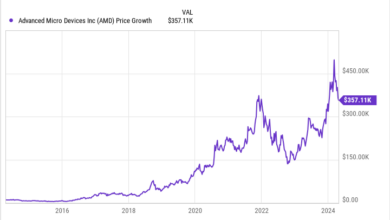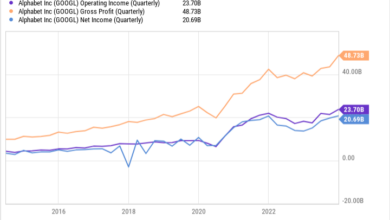3 Brilliant Artificial Intelligence (AI) Growth Stocks With Explosive Upside Potential

Last year was something of a coming-out party for artificial intelligence (AI), as Wall Street and Main Street alike were introduced to the capabilities of AI’s next-generation algorithms. It didn’t take investors long to realize that a number of the stock market’s best-performing stocks had something in common — they had AI in their DNA.
Bank of America analyst Michael Hartnett coined the term “Magnificent Seven,” from the 1960 film of the same name, to describe this group of high-growth stocks, listed in alphabetical order:
-
Alphabet
-
Amazon
-
Apple
-
Meta Platforms
-
Microsoft
-
Nvidia
-
Tesla
It’s easy to see how these market leaders were lumped together, but the intense focus on these stocks can be myopic, particularly if done to the exclusion of all others. Don’t get me wrong: I own shares of all of the Magnificent Seven stocks and don’t have plans to sell any of them. That said, I believe there are compelling opportunities outside this septet.
Let’s look at three AI stocks that have the potential to deliver explosive upside — that are not part of the Magnificent Seven.

1. Arm Holdings
Arm Holdings (NASDAQ: ARM) is best known for creating the blueprints for many of the world’s most widely used central processing units (CPUs). The company’s designs are ubiquitous, reaching into every area of technology, most notably cloud computing, hyperscale computing, and data centers.
This positioning gave the company the inside track when generative AI emerged last year, as a great deal of AI processing will be done in the cloud and data centers. Arm’s most recent (read: most lucrative) designs are all the rage as data center operators scramble to upgrade to more robust processors necessary to handle the rigors of AI. Take Nvidia’s GH200 Grace Hopper Superchip, for example. It combines accelerated CPU and GPU technology to meet that need,employing 144 of Arm’s top-of-the-line version 9 (V9) CPU cores.
For its fiscal 2024 third quarter, ended Dec. 31, Arm generated record revenue of $824 million, up 14% year over year. That performance was fueled by license revenue that grew 18% and record royalty revenue that jumped 11%. It also drove adjusted earnings per share (EPS) to $0.29, a 32% increase. However, the company’s remaining performance obligation (RPO), which provides a glimpse into sales trends, illustrates Arm’s future potential. RPO climbed 38% year over year to $2.43 billion, suggesting its accelerating growth has just begun.
Arm stock might seem expensive using the most popular valuation metrics, which fail to factor in its growth trajectory. However, its forward price/earnings-to-growth (PEG) ratio clocks in at less than 1, the standard for an undervalued stock.
2. Super Micro Computer
While Arm handles the CPU part of the AI equation, Super Micro Computer (NASDAQ: SMCI), also known as Supermicro, provides the specialty servers designed to handle the rigors of AI. Supermicro offers a variety of high-end servers that sport cutting-edge AI processors from the likes of Nvidia, Advanced Micro Devices, and Intel, among others.
Furthermore, the company’s focus on energy efficiency is the stuff of legend. Since AI systems require a deal of juice to process, Supermicro systems have enjoyed a commensurate spike in demand, which is evident in its recent financial results.
For the company’s fiscal 2024 second quarter, ended Dec. 31, Supermicro generated record revenue that surged 103% year over year to $3.66 billion, while diluted EPS soared 85% to $5.10.
If that weren’t enough, management’s forecast calls for its growth to accelerate, guiding for third-quarter revenue of $3.9 billion at the midpoint, representing 205% year-over-year growth.
Like Arm, Supermicro’s valuation looks stretched when using the price-to-earnings or price-to-sales ratio, the two most commonly employed valuation metrics. Yet its forward PEG ratio, which factors in its accelerating growth, comes in at less than 1, suggesting it’s a bargain.
3. Palantir Technologies
Palantir Technologies (NYSE: PLTR) is no stranger to AI. The company hung out its shingle more than two decades ago, with the initial goal of helping the U.S. government stop terrorists in their tracks. The company has since expanded its mandate, providing enterprise-level businesses with data mining and business analytics services fueled by AI.
That expertise in AI made Palantir the first stop for many companies looking to adopt generative AI, and the company pivoted to meet that need. The fruit of its efforts was the Artificial Intelligence Platform (AIP), a system designed to help businesses identify their most mission-critical needs and automate the solutions. By working side by side with Palantir’s engineers, users build customized AI-powered tools to suit their needs. Furthermore, Palantir’s intensive boot camp helps companies develop solutions in as little as one to five days.
The company’s success was evident in its most recent results. In the fourth quarter, revenue of $608 million marked a 20% year-over-year jump, while its EPS of $0.04 quadrupled. However, U.S. commercial revenue, which includes AIP, grew 70% year over year, while the company’s total contract value soared 107%. As a result, Palantir’s forecast calls for U.S. commercial revenue to grow by at least 40% in 2024, though management’s guidance tends to be conservative.
Like Arm and Supermicro, Palantir sports a forward PEG ratio of less than 1, suggesting the stock is undervalued.
Should you invest $1,000 in Palantir Technologies right now?
Before you buy stock in Palantir Technologies, consider this:
The Motley Fool Stock Advisor analyst team just identified what they believe are the 10 best stocks for investors to buy now… and Palantir Technologies wasn’t one of them. The 10 stocks that made the cut could produce monster returns in the coming years.
Stock Advisor provides investors with an easy-to-follow blueprint for success, including guidance on building a portfolio, regular updates from analysts, and two new stock picks each month. The Stock Advisor service has more than tripled the return of S&P 500 since 2002*.
*Stock Advisor returns as of March 11, 2024
Suzanne Frey, an executive at Alphabet, is a member of The Motley Fool’s board of directors. Randi Zuckerberg, a former director of market development and spokeswoman for Facebook and sister to Meta Platforms CEO Mark Zuckerberg, is a member of The Motley Fool’s board of directors. John Mackey, former CEO of Whole Foods Market, an Amazon subsidiary, is a member of The Motley Fool’s board of directors. Danny Vena has positions in Alphabet, Amazon, Apple, Meta Platforms, Microsoft, Nvidia, Palantir Technologies, Super Micro Computer, and Tesla. The Motley Fool has positions in and recommends Advanced Micro Devices, Alphabet, Amazon, Apple, Meta Platforms, Microsoft, Nvidia, Palantir Technologies, and Tesla. The Motley Fool recommends Intel and recommends the following options: long January 2023 $57.50 calls on Intel, long January 2025 $45 calls on Intel, long January 2026 $395 calls on Microsoft, short January 2026 $405 calls on Microsoft, and short May 2024 $47 calls on Intel. The Motley Fool has a disclosure policy.
Beyond the “Magnificent Seven”: 3 Brilliant Artificial Intelligence (AI) Growth Stocks With Explosive Upside Potential was originally published by The Motley Fool
Source link




